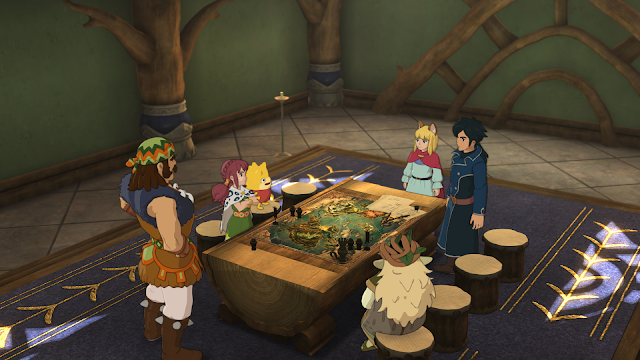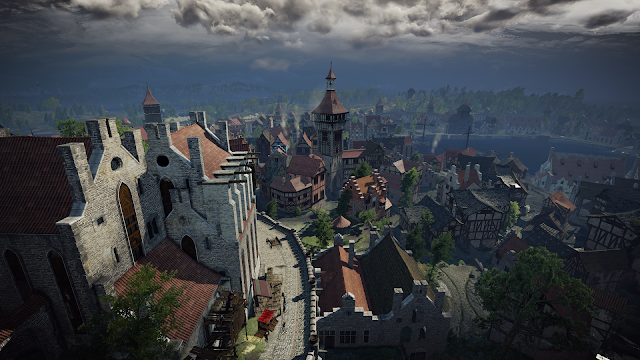In purely mechanical terms,
Ni no Kuni 2 is basically a collection of minigames. You might expect this to spoil the overall experience, but something about
Ni no Kuni 2 helps to make it more than just the sum of its parts. Tied together by a strong story, this collection of minigames becomes a masterpiece which overcomes the limitations of genre.
You play
Ni no Kuni 2 as the deposed Prince of Ding Dong Dell - Evan Pettiwhisker Tildrum. Founding a kingdom called Evermore, you start by ruling a ragtag band of brigands and pirates, but ultimately bring peace to the world by uniting the realms of Goldpaw, Hydropolis, Broadleaf, and your native Ding Dong Dell under a constitution called the Declaration of Interdependence. (You may want to look that one over again because you probably didn’t read it right). Assuming the role of a great king, you’re naturally expected to slay monsters, lead armies, and govern your capital. You go about this by completing a series of surprisingly diverse minigames. Because their mechanics are drawn from a variety of different genres, the only thing which truly ties these together is their consistency with the central narrative.
The development studio behind
Ni no Kuni 2, Level-5, borrowed mechanics from the fighting, real-time strategy, and management genres to create these minigames. Firmly couched in their fantasy setting, each minigame helps to create to an overall experience which defies the typical categories of game design.
 |
| You assume the role of a deposed prince |
The combat system is clearly inspired by the fighting genre. Taking place within a strictly defined space, combat basically consists of an isolated round or match in which your party squares off against a variety of possible opponents. In terms of tactics, you have both melee and ranged options. Rushing headlong at your enemies, you can defeat them with a combination of quick and charged attacks, but you can also keep your distance in order to whittle away their hit points with arrows, bullets, or spells. The combat system even has an equivalent to randomized item pickups. Benefiting from their offensive and defensive abilities, you can bring what are called Higgledies into battle with you. These are probably best described as fairies. They normally just roam around the combat arena, but Higgledies periodically gather together to prepare a powerful attack which you can activate by approaching their position. They’ll sometimes heal your party members, too.
 |
| The combat draws from beat 'em up and fighting games |
Borrowing from the real-time strategy genre, skirmish battles put you in command of a small army. Your objective is to capture and hold a series of control points. Managing a resource called Might, you need to be careful about how your forces are deployed, though. You can earn more by defeating enemies, but you’ll need to spend some if you’re ever compelled to call for reinforcements. In other words, the best way to keep from running out of Might is to have a solid strategy. There are sword, spear, hammer, and bow units in the game, so you need to figure out the order of battle which best answers to the strengths and weaknesses of each class. You can take up to four units of any class into battle with you. Since they have different special abilities, you’ll definitely want to think hard about your build. Special abilities can turn the tide of battle when they’re used effectively. Airstrikes for example can be absolutely devastating.
 |
| Skirmish battles have you leading a small army |
You get to govern your capital whenever you’re in Evermore. Borrowing from the management genre, this consists of building facilities, organizing citizens, and assigning research. Facilities generate a currency called Kingsguilders over time, so you have to figure out the most effective way to maximize your income through investment. When you’ve saved up enough Kingsguilders, you can either purchase land or upgrade existing facilities. They provide you with a lot more income once they’ve been fully upgraded, but expansion is definitely in your best interest. You can squeeze even more Kingsguilders from facilities by staffing them with citizens and performing research, so the optimal growth strategy is almost always a balanced approach. You can increase their staff size by upgrading them, but facilities are only allowed so many upgrades. You’ll in other words need to be acquiring land for new facilities on a fairly regular basis. Your citizens are only good for much when they’re working.
 |
| You have to manage your capital whenever you aren't adventuring |
Spend enough time playing
Ni no Kuni 2 and you’ll notice that it borrows mechanics from several different genres. While it definitely draws from role-playing games, puzzlers, and even a bit from platformers,
Ni no Kuni 2 leans most heavily on the fighting, real-time strategy, and management genres. These were used by Level-5 to create the minigames which make up most of the overall experience.
 |
| You solve more than a few puzzles |
 |
| Some segments have you platforming |
While you could probably call it a collection of minigames,
Ni no Kuni 2 is definitely more than just the sum of its parts. What keeps it from feeling cobbled together? Since they’re perfectly consistent with its fantasy setting, the surprisingly diverse minigames which make up
Ni no Kuni 2 come together to create an overall experience which overcomes the limitations of genre. While many developers would have done the reverse, Level-5 in this case allowed the story to inform the choice of mechanics. What could be more natural for a great king than slaying monsters, leading armies, and governing his capital? Defying the typical categories of game design, the result was a masterpiece which truly makes you think differently about genre.









